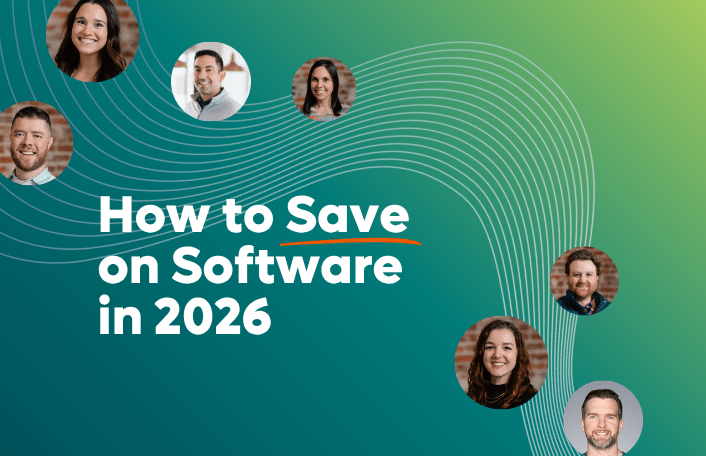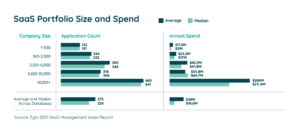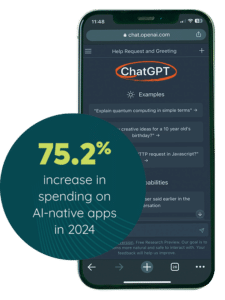
We Asked 7 Experts How to Save $1M on Software. Here’s What…
Table of Contents ToggleWhat Is IT Procurement?Importance of IT ProcurementThe Evolution...
Back
Back
Search for Keywords...
Blog

11/25/2025
Table of Contents
Modern IT procurement has become a strategic discipline for CFOs who need clearer visibility into software portfolios, tighter control over SaaS growth, and a smarter approach to long-term technology investments. According to Zylo’s 2025 SaaS Management Index, average SaaS spending rose 9.3% YoY, even though portfolios grew only 2.2%—a gap that underscores how quickly costs are outpacing tool growth.
As budgets come under pressure heading into 2026, you need procurement practices that reduce waste, improve compliance, and ensure every dollar spent on technology delivers measurable value.
IT procurement covers the full SaaS lifecycle of sourcing, evaluating, purchasing, and managing the technology your organization depends on. It has become far more complex in the SaaS era, especially as average SaaS portfolios now include 275 applications—a scale that makes visibility, governance, and cost control significantly harder without a structured procurement function.
Business need strong IT procurement practices to:
Visibility into what software is being purchased and how it’s used helps procurement understand whether a tool delivers enough value to justify its cost. It’s becoming more important as SaaS spending grows. In 2024 alone, organizations spent an average of $49M per company. The cost per employee also rose 21.9% to an average of $4,830.

In addition, long-term financial planning becomes more effective with procurement’s involvement. Reliable data around renewals, usage, and total cost of ownership improves forecasting accuracy. Budgets are monitored more closely and unnecessary costs are more likely to be avoided.
The renewal is a pivotal moment for driving cost savings. With IT procurement, you can proactively manage each renewal, focused on those that have the highest savings potential.
Zylo data shows that the average organization has 247 renewals annually. With that scale, IT procurement has shifted from an occasional purchasing activity into a continuous operational discipline.
Companies now manage constant renewals, decentralized buying, and widespread shadow IT. Procurement has also expanded beyond evaluating just one-time purchases. Teams are also assessing subscription models, consumption pricing, integration requirements, and ongoing vendor risk.
To keep up, procurement teams must work closely with IT, finance, security and business stakeholders. This continuous cycle requires higher data transparency, better tooling, and cross-functional collaboration to keep spend aligned with business objectives.
 The 2025 SaaS Management Index shows that average spending on AI-native apps grew 75.2%, highlighting the criticality of AI for everyday work. AI is reshaping procurement by helping organizations:
The 2025 SaaS Management Index shows that average spending on AI-native apps grew 75.2%, highlighting the criticality of AI for everyday work. AI is reshaping procurement by helping organizations:
As SaaS portfolios expand and pricing grows more complex, AI helps teams keep up with scale and make data-backed decisions.
AI improves speed and accuracy in IT procurement by automating time-consuming tasks and enhancing decision-making with real-time data. It helps teams move faster while maintaining oversight by:
By reducing manual work and surfacing key insights earlier, AI enables IT, procurement, and finance teams to make more informed, consistent decisions—without slowing down the buying process.
AI simplifies vendor evaluation in fast-changing SaaS environments. It quickly reviews vendor documents, security questionnaires, and performance data to flag risks and gaps, such as:
AI also compares similar tools by cost, adoption, and alignment to your standards. When combined with data from your current stack, AI reveals where a requested tool overlaps or adds unique value—leading to faster, smarter procurement decisions.
Zylo data shows 66.5% of IT leaders experienced unexpected SaaS charges, often tied to usage- or AI-based pricing models. AI helps surface patterns and risks such as:
AI models are well-suited to analyzing historical spend, usage trends, and renewal patterns so you can forecast SaaS costs with greater accuracy. This matters, because unused licenses alone now represent $21M in estimated annual waste for the average enterprise. Organizations have a significant optimization opportunity when forecasting is proactive and data driven.

For CFOs, this leads to stronger alignment between procurement and financial planning. As a result, they can:
Instead of reacting at the last minute during renewal cycles, you can make proactive, data-backed decisions that support long-term cost control.
IT procurement best practices are shifting toward continuous oversight, shared visibility across teams, and tighter control over SaaS growth. As you plan for 2026, you need processes that reduce waste, improve compliance, and support long-term technology strategy. These areas represent the core practices shaping modern procurement:
Anchor procurement decisions to your organization’s long-term goals. With SaaS accounting for over 60% of total software spend, treat every purchase as a strategic investment—not just a transaction.
To drive impact:
Use strategic alignment to reduce tool sprawl, streamline decisions, and create consistency—even in decentralized environments. Stay connected to business and IT priorities to build a governed, cost-effective SaaS portfolio that strengthens productivity, reduces risk, and protects your budget.
Establish a written procurement policy to guide how teams request, review, and approve software. Define clear requirements for:
Set these expectations upfront to enforce governance, avoid overspend, and ensure consistent purchasing decisions.
Assign clear roles to streamline workflows. Specify who approves technical fit, negotiates contracts, and monitors usage. Clarify ownership to reduce confusion and enable a repeatable, efficient purchase process every time.
With business units now driving 70% of SaaS spend, involve them early to maintain strategic control. Engage business leaders, IT, and security teams at the start of the procurement process.

Doing so eliminates last-minute blockers, accelerates approvals, and ensures every request meets technical, integration, and governance requirements.
Prioritize early collaboration to:
When stakeholders help evaluate and select the right solution, they’re more likely to champion its success post-implementation.
Set your procurement process up for success by clearly outlining requirements from the start. Strong inputs lead to well-matched solutions, smoother evaluations, and more predictable outcomes.
To guide accurate vendor comparisons and pricing transparency, define:
Procurement consistently achieves stronger outcomes when requirements are specific. This clarity helps identify the right-fit solutions, align stakeholders, and streamline selection—all while ensuring pricing aligns with actual usage. Clear requirements reduce ambiguity and give you greater control throughout the procurement lifecycle.
Upfront pricing rarely reflects what SaaS tools cost over time. Your TCO analysis should account for elements such as:
A full TCO perspective helps you prevent budget surprises and compare vendors on long-term value rather than sticker price.
Establish a consistent vendor evaluation process to improve decision quality and accelerate selection. Use prequalification to validate key criteria, including:
Maintain a prequalified vendor list to enable teams to move quickly with trusted options. This approach streamlines reviews, supports smarter purchases, and encourages the use of approved tools—strengthening governance and reducing process delays.
Strengthen your SaaS strategy by integrating security reviews throughout the procurement process. Prioritize tools that meet enterprise standards by verifying:
Conducting a consistent security review ensures each tool aligns with your organization’s standards and regulatory requirements—well before contracts are signed. This approach builds trust, reduces risk, and reinforces a secure, scalable SaaS ecosystem.
Implement consistent documentation to guide every request from intake to approval. Standardizing forms and evaluation criteria eliminates ambiguity, accelerates decisions, and supports operational scale.
Use templates to capture complete information from the start, reducing time spent on back-and-forth and ensuring alignment. Include:
This consistency strengthens transparency, supports clear vendor comparisons, and simplifies audits. Over time, standardized documentation helps teams reduce waste, avoid duplication, and build a more efficient, scalable SaaS procurement process.
Promote transparency from the start of the procurement process to ensure stronger vendor evaluations and smarter contract decisions. Ask vendors to provide clear, structured documentation that helps your team assess value, anticipate costs, and identify potential risks early.
Prioritize requesting:
Reviewing these materials upfront enables you to compare vendors with confidence, negotiate favorable terms, and secure long-term value—without unexpected costs later in the lifecycle.
Accelerate your SaaS procurement process by automating routine tasks that slow down intake, evaluation, and approvals. As decentralized buying increases, automation becomes essential for managing volume, enforcing consistency, and reducing delays.
Leverage automation to:
Automate policy checks, verify intake completeness, and ensure documentation is in place to make it easier for stakeholders to follow the process. This consistency improves pipeline visibility across procurement, IT, and Finance—highlighting upcoming renewals, required actions, and potential risks.
Over time, automation strengthens governance, reduces cycle times, and equips your team to manage spend with greater speed and accuracy.
“Without digitalization, procurement can’t realize their potential.”
Embed a SaaS Management Platform (SMP) into your procurement workflow to gain real-time visibility into your software stack—beyond what traditional tools offer. SMPs provide operational insights that help you make faster, smarter, and more cost-effective decisions.
Use an SMP to:
While Procure-to-Pay (P2P) systems manage transactions, SMPs reveal how software is used across your business. This gives you the full context behind every purchase.
Tap into insights like:
With these capabilities in place, procurement teams can avoid waste, improve renewal outcomes, and base every decision on accurate, day-to-day usage data.
Treat every software purchase as a strategic decision by evaluating risk upfront. Use structured assessments to review vendor reliability, data handling practices, downtime impact, and integration complexity.
Embed these assessments into your procurement policy to:
By making risk reviews part of the process, you gain clarity, reduce uncertainty, and protect your organization as your SaaS footprint grows.
Approach every SaaS renewal with a clear negotiation strategy powered by real data. Combine usage insights, market benchmarks, and renewal timing to secure terms that align with both budget goals and business needs.
Guide your negotiation strategy by analyzing:
When negotiations are informed by real-world usage and market context, you can confidently shape agreements that support long-term strategy, maximize value, and maintain cost control.
Track vendor performance throughout the contract lifecycle, not just at renewal. Ongoing monitoring helps you validate service quality, assess roadmap progress, and surface potential risks early.
Focus on metrics such as:
Use this data to proactively decide whether to maintain, renegotiate, or replace a vendor before performance issues impact your business. Continuous evaluation strengthens vendor relationships, reduces surprises, and supports more strategic renewals.
Maintain accurate, centralized records to stay in control of your SaaS environment. Knowing what tools you own, who’s using them, and which licenses can be reassigned allows you to optimize spend and reduce risk.
Prioritize centralized tracking to:
Clear visibility becomes even more critical in organizations with distributed SaaS ownership. A centralized system of record equips you to manage usage, costs, and compliance with confidence.
Strengthen your role in SaaS governance by partnering closely with Finance and IT. Cross-functional collaboration enables smarter budget planning, tighter contract oversight, and better alignment with business strategy.
Take action by:
This partnership reinforces disciplined spending, aligns procurement with financial goals, and equips distributed teams to make smarter, data-driven decisions.
Keep your procurement process aligned with business growth by regularly reviewing and refining your workflows. Revisit approval paths, documentation standards, and vendor lists to ensure they reflect current priorities and operating models.
Strengthen decision-making by:
A proactive approach to optimization helps procurement scale with the business, eliminate bottlenecks, and maintain agility as needs evolve.
Treat renewals with the same rigor as new purchases by implementing a structured renewal governance process. With renewals often representing the largest portion of software spend, a proactive approach protects your budget and strengthens negotiation outcomes.
Improve renewal outcomes by:
With a consistent renewal process in place, you gain greater control, avoid last-minute approvals, and ensure every renewal supports your broader SaaS strategy.
Zylo helps IT procurement teams reduce waste, improve negotiations, and strengthen collaboration by grounding decisions in accurate, shared information. To understand how this plays out in real life, look at the following example.
Marigold, a global martech company, struggled to manage $45M in SaaS spend across 270 apps—complicated by seven acquisitions in five years. The team lacked visibility, needed faster integration, and aimed to control spend. With Zylo, Marigold’s procurement team built a centralized SaaS system of record, sped up M&A tech consolidation, and partnered with Managed Services to optimize spend.
“Zylo allows us to control spending better through connections to our financials – we know all the spend going out the door.”
— Karen Hodson, Global Real Estate & Procurement Officer
Key Outcomes:
Zylo helped Marigold shift from reactive cleanup to proactive, data-driven SaaS management at scale.
Marigold Uses Zylo to Save on Sprawling SaaS Costs & Streamline M&A Technology Integration
Discover how Marigold unlocked the door to nearly $1M in SaaS cost savings with Zylo, while undergoing a M&A tech integration and cutting software waste from their portfolio.
As organizations approach 2026 with rising software costs, strong IT procurement practices are essential for maintaining clarity, reducing waste, and improving decision quality. Zylo empowers teams with real-time visibility into applications, contracts, usage, and renewals—giving procurement, IT, and finance a unified source of truth.
With accurate data and consistent workflows, companies can transform SaaS Management from a recurring challenge into a strategic advantage. To see how Zylo can support your team’s procurement goals, request a demo and explore the platform firsthand.
Effective IT procurement focuses on visibility, consistency, and cross-functional collaboration. Teams see the best results when they:
These practices strengthen control and improve decision quality.
Hidden software costs often stem from shadow IT, unclear pricing, and unmanaged renewals. To reduce risk:
Better visibility and documentation help prevent unexpected charges.
An IT procurement policy ensures teams follow a consistent, efficient process. It clarifies:
This structure reduces delays, avoids duplicate purchases, and makes decisions more predictable.
Procurement is strategic and guides long-term software decisions through:
Purchasing executes the transaction with:
Together, they ensure smart selection and smooth execution.

Table of Contents ToggleWhat Is IT Procurement?Importance of IT ProcurementThe Evolution...

Table of Contents ToggleWhat Is IT Procurement?Importance of IT ProcurementThe Evolution...

Table of Contents ToggleWhat Is IT Procurement?Importance of IT ProcurementThe Evolution...

Table of Contents ToggleWhat Is IT Procurement?Importance of IT ProcurementThe Evolution...
| Cookie | Duration | Description |
|---|---|---|
| cookielawinfo-checkbox-analytics | 11 months | This cookie is set by GDPR Cookie Consent plugin. The cookie is used to store the user consent for the cookies in the category "Analytics". |
| cookielawinfo-checkbox-functional | 11 months | The cookie is set by GDPR cookie consent to record the user consent for the cookies in the category "Functional". |
| cookielawinfo-checkbox-necessary | 11 months | This cookie is set by GDPR Cookie Consent plugin. The cookies is used to store the user consent for the cookies in the category "Necessary". |
| cookielawinfo-checkbox-others | 11 months | This cookie is set by GDPR Cookie Consent plugin. The cookie is used to store the user consent for the cookies in the category "Other. |
| cookielawinfo-checkbox-performance | 11 months | This cookie is set by GDPR Cookie Consent plugin. The cookie is used to store the user consent for the cookies in the category "Performance". |
| viewed_cookie_policy | 11 months | The cookie is set by the GDPR Cookie Consent plugin and is used to store whether or not user has consented to the use of cookies. It does not store any personal data. |
